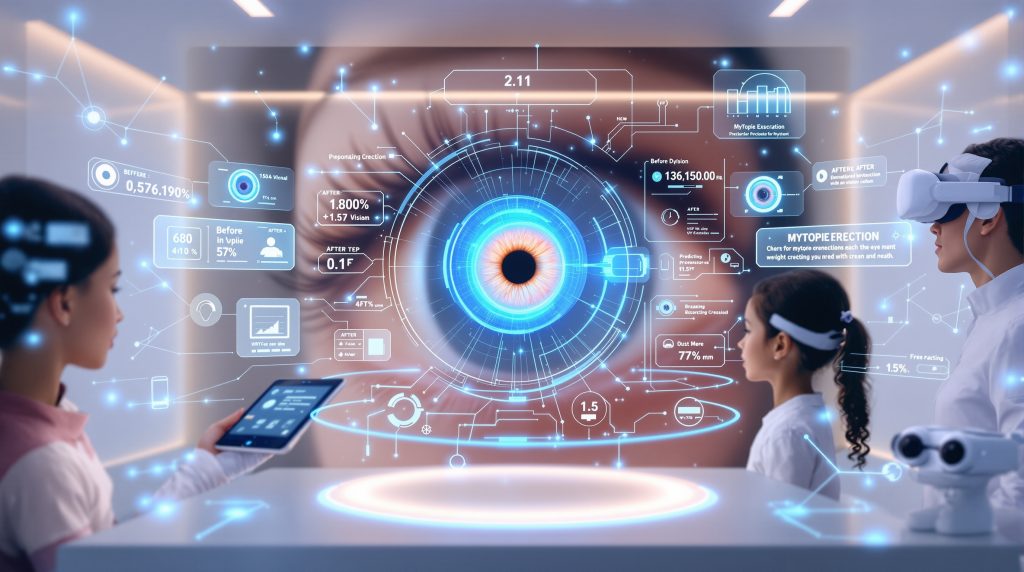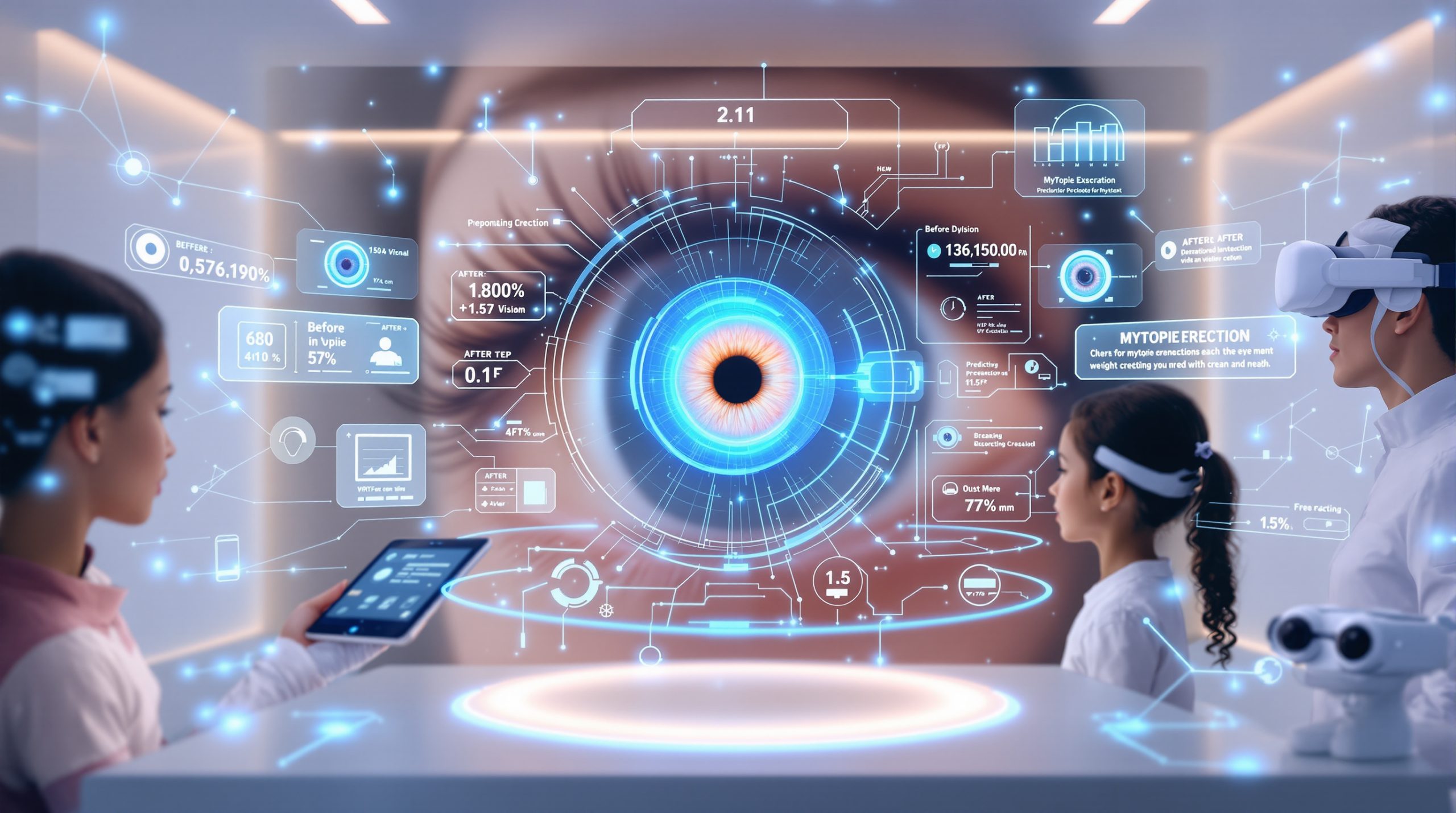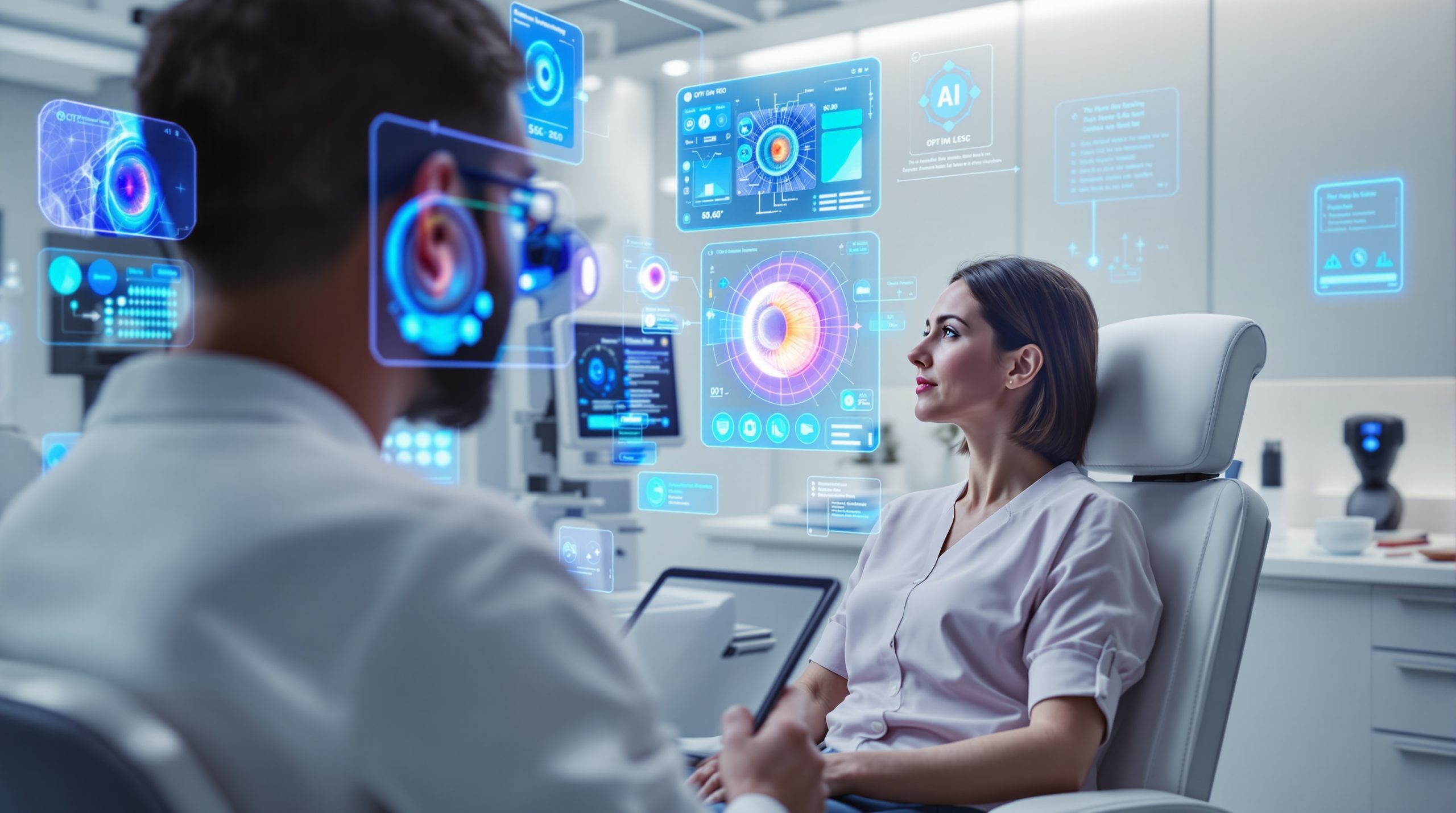Artificial Intelligence in Myopia Management: Transforming Detection, Prediction, and Treatment
What is Driving the Need for AI in Myopia Management?
The global myopia epidemic continues to accelerate, with projections indicating that nearly 50% of the world's population could be myopic by 2050. This unprecedented rise creates an urgent need for innovative approaches to detection, monitoring, and treatment. Artificial intelligence in myopia management has emerged as a powerful tool in addressing these challenges, offering capabilities that extend beyond traditional clinical methods.
Myopia management has evolved significantly in recent years, with evidence-based interventions now well-established. However, several persistent challenges remain:
- Early identification of at-risk children
- Accurate prediction of progression rates
- Personalization of treatment approaches
- Consistent monitoring of treatment efficacy
- Accessibility of specialized care in underserved regions
AI technologies are uniquely positioned to address these challenges through advanced data analysis, pattern recognition, and predictive modeling. This integration represents a new frontier in eye care, with potential to revolutionize how we detect, predict, and treat this growing global health concern as part of the broader mining industry evolution.
How is AI Enhancing Myopia Detection and Screening?
Advanced Imaging Analysis
AI algorithms, particularly deep learning models, have demonstrated remarkable capabilities in analyzing retinal images to detect early signs of myopia. These systems can identify subtle changes in the optic nerve head, retinal vasculature, and macular regions that may indicate myopic development or progression.
Current applications include:
- Fundus Image Analysis: AI systems can automatically assess optic disc parameters, retinal vessel patterns, and other biomarkers associated with myopia development.
- OCT Interpretation: Deep learning models analyze optical coherence tomography scans to detect early choroidal thinning and other structural changes associated with myopic progression.
- Automated Refraction Assessment: AI-powered systems can estimate refractive error from digital images, potentially enabling screening without specialized equipment.
Smartphone-Based Screening Tools
The integration of AI with smartphone technology has created new opportunities for accessible myopia screening. Several systems have demonstrated promising results:
| Screening Technology | Key Features | Accuracy Metrics |
|---|---|---|
| Photorefraction Apps | Uses smartphone camera flash to analyze light reflexes | MAE 0.79D-0.99D for myopia between -2.00D and -4.00D |
| Vision Testing Apps | Digital acuity and contrast sensitivity testing | 93% sensitivity, 81% specificity for myopia >-2.00D |
| Behavioral Monitoring | Tracks device usage patterns and reading distances | Correlates with myopia risk factors |
These technologies hold particular promise for expanding screening in regions with limited access to eye care professionals, potentially identifying at-risk children who might otherwise go undetected until significant progression has occurred.
Can AI Predict Myopia Onset and Progression?
Predictive Modeling for Myopia Risk
One of the most promising applications of AI in myopia management is predicting which children will develop myopia and how quickly it will progress. Advanced algorithms analyze multiple risk factors to generate personalized risk profiles, similar to how data-driven operations have transformed other industries.
The DeepMyopia algorithm represents a significant advancement in this area:
- Trained on over 1.6 million fundus images
- Successfully predicts myopia onset within one to three years
- Accurately stratifies children into low and high-risk categories
- Enables targeted intervention strategies based on risk level
This predictive capability allows for earlier intervention, potentially before myopia develops, which could significantly improve long-term outcomes.
Progression Pattern Recognition
AI systems can identify patterns in myopia progression that may not be apparent through traditional clinical assessment. These patterns help clinicians understand:
- Which children are likely to experience rapid progression
- How different treatments might affect progression in specific patient subgroups
- When progression patterns suggest a need for treatment modification
By recognizing these patterns, AI supports more informed clinical decision-making and helps optimize treatment strategies for individual patients, representing an important exploration trend for 2025.
How is AI Personalizing Myopia Treatment Approaches?
Treatment Selection Optimization
The growing array of myopia management options—including specialized spectacles, contact lenses, pharmaceutical interventions, and light therapies—creates complexity in determining the optimal approach for each child. AI systems can analyze multiple factors to recommend personalized treatment plans:
- Patient characteristics (age, baseline myopia, progression rate)
- Environmental and behavioral factors
- Family history and genetic markers
- Previous treatment responses
- Compliance patterns and lifestyle considerations
These recommendations help clinicians navigate treatment decisions and explain options to parents with greater confidence and precision.
Dynamic Treatment Adjustment
AI algorithms continuously analyze treatment outcomes, enabling dynamic adjustments to optimize efficacy:
- Identifying when treatment efficacy is declining
- Suggesting modifications to improve results
- Predicting when combination therapies might be beneficial
- Recommending optimal timing for treatment transitions
This adaptive approach represents a shift from static treatment protocols to dynamic, personalized management strategies that evolve with the patient's needs, similar to advances in AI transforming drilling and other precision-oriented fields.
What Role Does AI Play in Treatment Monitoring and Compliance?
Remote Monitoring Systems
AI-enabled remote monitoring technologies are transforming how clinicians track treatment efficacy and patient compliance:
- Smart Optical Devices: Contact lenses and spectacles with embedded sensors can track wearing time and visual behavior patterns.
- Home Monitoring Tools: AI-powered devices allow for regular assessment of refractive status and axial length between office visits.
- Digital Behavior Tracking: Applications monitor near work duration, reading distance, and outdoor time to assess compliance with behavioral recommendations.
These technologies provide more continuous data than periodic clinical visits alone, enabling earlier detection of treatment failure or compliance issues.
Compliance Enhancement Strategies
AI systems analyze compliance patterns to develop personalized strategies for improving adherence:
- Identifying specific barriers to compliance for individual patients
- Generating tailored reminders and educational content
- Predicting periods of likely non-compliance and providing preemptive support
- Gamifying treatment adherence through engaging digital interfaces
These approaches address one of the most significant challenges in myopia management—maintaining consistent treatment adherence over multiple years.
What New AI-Powered Treatments Are Emerging?
Augmented Optical Designs
AI is driving innovation in optical treatment designs, creating more sophisticated approaches to myopia control:
- Optimized Defocus Profiles: Machine learning algorithms analyze individual visual systems to determine optimal defocus patterns for maximum efficacy.
- Adaptive Lens Technologies: Smart lenses that adjust their optical properties based on viewing conditions and visual tasks.
- Personalized Lens Designs: Custom optical designs based on individual eye characteristics and progression patterns.
These advanced optical approaches aim to improve both efficacy and visual experience for patients undergoing myopia control.
Virtual Reality and Simulated Environments
AI-powered virtual reality systems represent an emerging frontier in myopia management:
- Simulated Outdoor Environments: VR systems that mimic the protective effects of outdoor light exposure.
- Visual Training Programs: Interactive environments designed to modify visual behaviors associated with myopia progression.
- Engagement-Based Interventions: Gamified experiences that encourage compliance with treatment protocols.
While still experimental, these approaches highlight the potential for artificial intelligence in myopia management to create entirely new treatment modalities beyond traditional optical and pharmaceutical interventions, adopting principles of modern mine planning in terms of efficiency and optimization.
What Challenges and Limitations Exist for AI in Myopia Management?
Data Quality and Representation
The effectiveness of AI systems depends heavily on the quality and representativeness of their training data:
- Many models are trained primarily on Asian populations, limiting generalizability
- Data collection standards vary significantly between clinical settings
- Privacy concerns restrict data sharing and limit dataset size
- Historical biases in clinical data may be perpetuated in AI systems
Addressing these limitations requires collaborative efforts to develop diverse, representative datasets while maintaining patient privacy and ethical standards, as highlighted in recent research on myopia management.
Clinical Integration Barriers
Despite their potential, AI systems face significant barriers to clinical integration:
- Regulatory approval processes for AI-based medical technologies remain complex
- Clinical workflows may not easily accommodate AI-based decision support
- Cost considerations may limit adoption in some practice settings
- Clinician acceptance and trust in AI recommendations varies widely
Successful implementation requires thoughtful integration strategies that complement rather than disrupt established clinical practices.
Explainability and Trust
The "black box" nature of some AI algorithms creates challenges for clinical adoption:
- Clinicians may be reluctant to follow recommendations they cannot fully understand
- Patients and parents may question treatment decisions based on AI systems
- Regulatory bodies increasingly require explainable AI for medical applications
- Liability concerns arise when decision-making is partially delegated to AI systems
Developing more transparent, explainable AI models remains an important research priority in this field, as discussed in comprehensive studies on myopia interventions.
How Might AI Transform Myopia Management in the Future?
Integrated Care Systems
The future of artificial intelligence in myopia management likely involves comprehensive, integrated systems that span the entire care continuum:
- Continuous Risk Assessment: Ongoing evaluation of myopia risk factors from multiple data sources.
- Automated Screening Programs: AI-powered community screening initiatives that identify at-risk children.
- Decision Support Ecosystems: Integrated platforms that guide clinical decision-making across all aspects of care.
- Predictive Maintenance: Systems that anticipate when treatment adjustments will be needed before efficacy declines.
These integrated approaches promise more cohesive, proactive care than current fragmented systems.
Population Health Applications
AI systems will increasingly support population-level myopia management strategies:
- Identifying geographic and demographic patterns in myopia development
- Evaluating the effectiveness of public health interventions
- Optimizing resource allocation for screening and treatment programs
- Predicting future myopia burden to inform healthcare planning
These applications extend beyond individual patient care to address myopia as a public health challenge.
Precision Medicine Approaches
The ultimate promise of AI in myopia management is truly personalized care:
- Genetic and environmental risk factor integration
- Individual visual system modeling for treatment optimization
- Continuous adaptation of treatment approaches based on response patterns
- Lifelong myopia management strategies tailored to changing needs
This precision medicine approach represents a significant advancement over current standardized protocols and treatment algorithms.
What Are the Practical Implications for Eye Care Providers?
Preparing for AI Integration
Eye care professionals can take several steps to prepare for increasing AI integration:
- Develop digital literacy and basic understanding of AI principles
- Establish standardized data collection protocols in clinical practice
- Participate in AI validation studies and clinical trials
- Advocate for ethical AI development that prioritizes patient outcomes
These preparations help ensure that clinicians remain central to care delivery as AI systems become more prevalent.
Evolving Professional Roles
The integration of artificial intelligence in myopia management will likely transform professional roles:
- Increased focus on interpreting AI recommendations and explaining them to patients
- More time for complex decision-making and patient education
- Reduced time spent on routine measurements and calculations
- New specializations in digital health and AI-augmented care
Rather than replacing clinicians, AI is likely to enhance their capabilities while changing how they allocate their time and expertise.
FAQs About AI in Myopia Management
How accurate are AI systems at predicting myopia progression?
Current AI prediction models demonstrate accuracy rates between 80-93% for predicting myopia onset within 1-3 years, with continuous improvement as algorithms and datasets evolve. The most advanced systems incorporate multiple data inputs, including imaging, refractive measurements, and risk factor profiles.
Can AI help determine which myopia treatment will work best for a specific child?
Yes, emerging AI systems analyze individual characteristics, including age, baseline myopia, progression rate, and lifestyle factors to recommend personalized treatment approaches. While still developing, these systems show promise in matching patients with the interventions most likely to succeed for their specific profile.
Are there privacy concerns with AI-based myopia management systems?
Privacy considerations are significant, particularly for systems that collect continuous data from children. Best practices include transparent data policies, appropriate consent processes, secure data storage, and minimizing data collection to what's clinically necessary. Regulatory frameworks continue to evolve in this area.
How will AI affect the cost of myopia management?
AI may initially increase costs through technology investment but could ultimately reduce expenses by improving treatment efficacy, reducing progression, and preventing complications. The economic impact will depend on implementation models, reimbursement structures, and the demonstrated value of improved outcomes.
Conclusion: The Transformative Potential of AI in Myopia Management
Artificial intelligence in myopia management represents a powerful new frontier in the global effort to address the myopia epidemic. By enhancing detection capabilities, improving prediction accuracy, personalizing treatment approaches, and supporting ongoing monitoring, AI technologies have the potential to fundamentally transform how we manage this growing public health challenge.
The integration of AI into myopia management is not without challenges. Questions about data quality, clinical integration, explainability, and accessibility remain important considerations as these technologies continue to develop. However, the potential benefits—earlier intervention, more personalized care, improved outcomes, and broader access to specialized management—suggest that AI will play an increasingly central role in myopia care.
As research continues and technologies mature, the collaboration between eye care professionals and AI systems promises to create new possibilities for protecting children's vision in the face of the global myopia epidemic. The future of myopia management will likely be defined not by AI alone, but by the thoughtful integration of artificial and human intelligence to deliver optimal care.
Ready to Gain an Edge in Mineral Discovery Investments?
Discover how to capitalise on significant ASX mineral discoveries before the market reacts by exploring Discovery Alert's dedicated discoveries page, powered by their proprietary Discovery IQ model that transforms complex mineral data into actionable insights. Begin your 30-day free trial today at Discovery Alert to position yourself ahead of the market.




